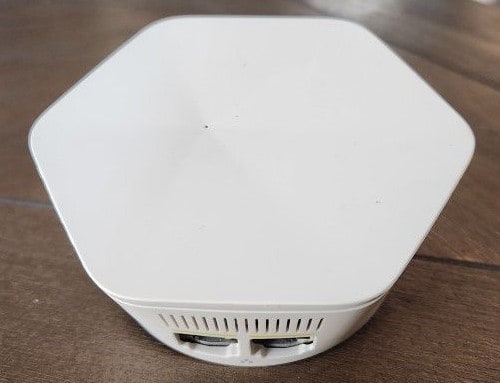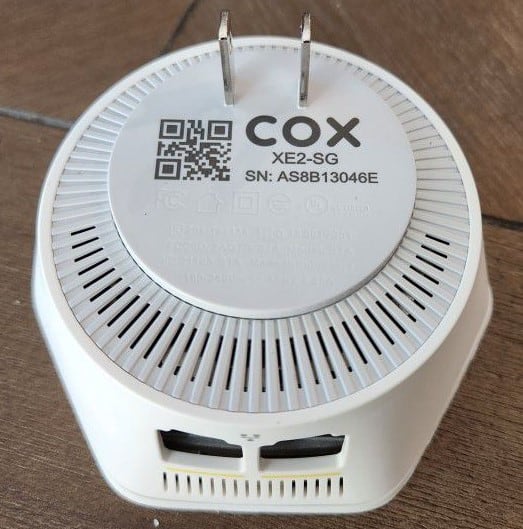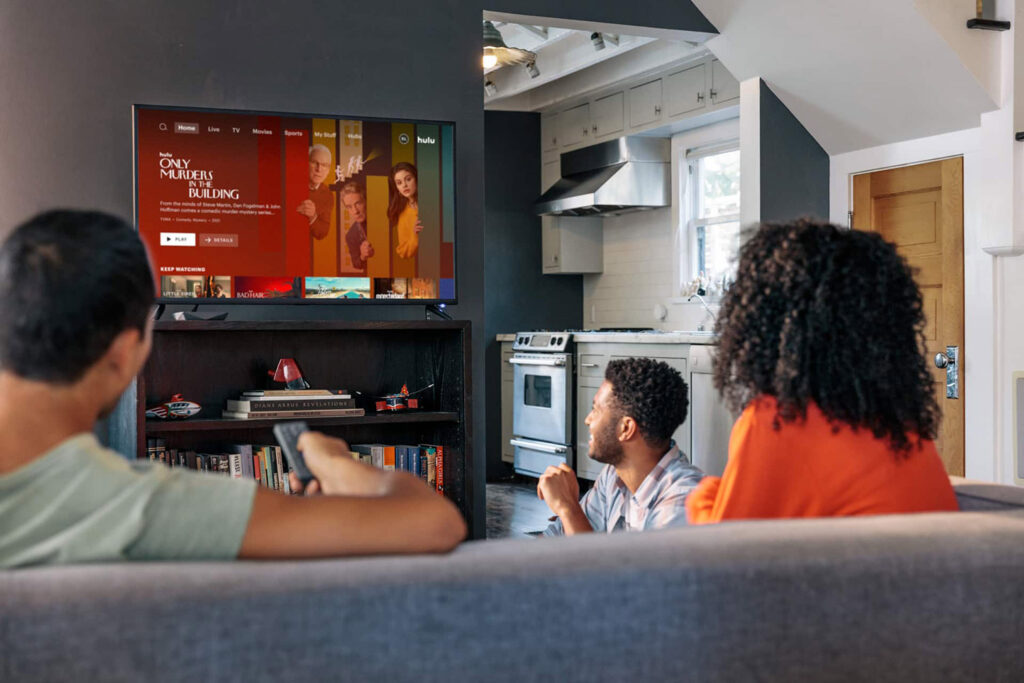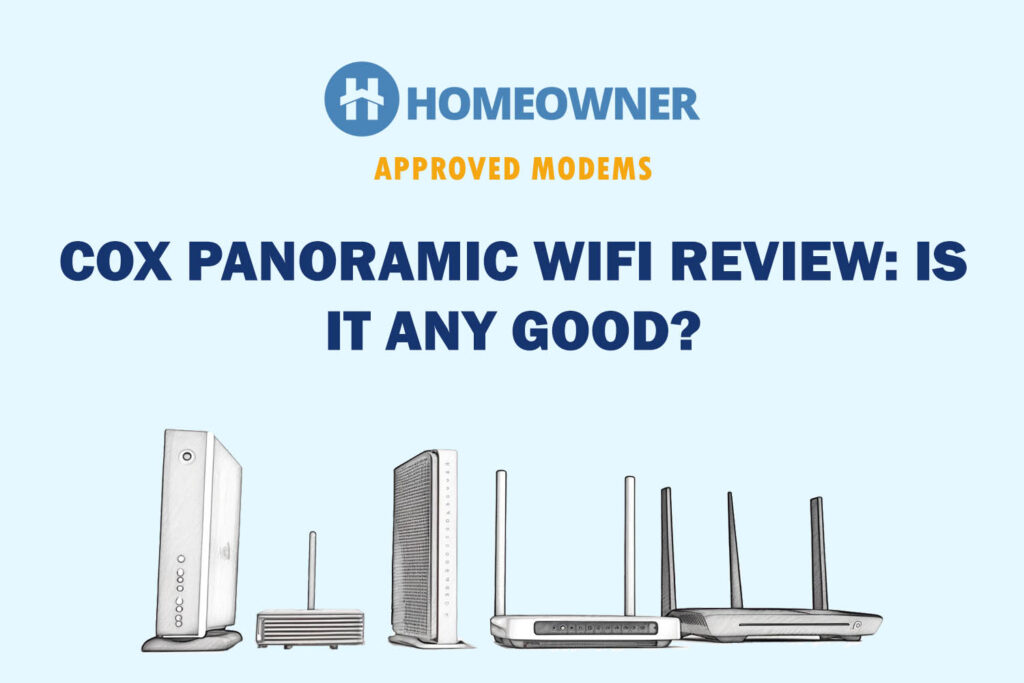The Panoramic WiFi gateway provided by Cox has a decent coverage range, but it falls short in large homes. As a solution, Cox WiFi Pods are available at $130 per unit. So, is it worth it, or should you consider third-party extenders?
Let's find that out!
Cox WiFi Pods Specs
| Wireless Standard | Wi-Fi 5 (802.11ac) |
| Aggregated Speed | AC3000 (3000 Mbps) |
| Band Frequency | Tri-band |
| 2.4 GHz Speed | 400 Mbps |
| 5 GHz (1) Speed | 867 Mbps |
| 5GHz (2) Speed | 1734 Mbps |
| WiFi Range | Up to 1,000 Sq Ft (with a single pod) |
| Maximum Device Capacity | Up to 15 devices (with a single pod) |
| Ports | 2 x Gig LAN |
| Suitable Internet Plan | Up to 1 Gbps |
| App Support | Yes |
| QoS Prioritization | No |
| MU-MIMO | Yes |
| Security Standard | WPA2 |
| Processor | Unknown |
| RAM | Unknown |
| NAND Storage | Unknown |
| Dimensions | 1.5 X 3.8 X 3.4 inches |
| Weight | Unknown |
Detailed Review of Cox Panoramic WiFi Pods
For the past two weeks, I had the Cox gateway paired with two of these pods as my primary internet source in a 3,700 Sq Ft two-level house. During this period, I evaluated them across multiple parameters including WiFi range, signal quality, device handling ability, speeds, and consistency.
Find my honest opinions on each in the subsequent sections below:
WiFi Coverage & Devices Capacity
The number of internal antennas present in these is unknown, but each pod promises coverage of up to 1,000 Sq Ft. While it's quite difficult to measure its actual coverage, with two pods in place, it could cover an area of around 1,400 Sq Ft.
The signal quality of devices connected to the pods’ network is decent, but not as strong as that of WiFi 6 extenders available in the market.
Regarding connection handling, the Pods have a limit of only 15 devices that can be connected at once. In my case, I had two laptops, four smartphones, and six security cameras connected, totaling 12 devices. This is a low number for a range extender costing over $130.
On the other hand, third-party WiFi extenders handle double the number of connections. Also, there were several instances of lags and signal drops at around 500 Sq Ft distance from the WiFi Pod.
Overall, I believe there is significant room for improvement in this area.
Wireless Speeds & Suitability
The Cox Panoramic pods support Wi-Fi 5 standard and operate on three simultaneous bands. As evident with tri-band WiFi routers, an extra band adds a lot to the wireless performance.
With that said, the Cox WiFi extender comes at a maximum speed of 3,000 Mbps, where the respective share on each band is as follows:
| 5 GHz (1): 1734 Mbps | 5 GHz (2): 867 Mbps | 2.4 GHz: 400 Mbps |
I paired it with a Panoramic WiFi gateway on a Gigablast connection and performed several speed tests at two locations. Here's what they turned out:
In the close proximity test at 30 feet from the extender placement, the respective download and upload speeds with valued at 201 Mbps and 21 Mbps, respectively.
And moving away at 60 feet from the pods got me respective speeds of 100 Mbps and 10 Mbps, respectively.

At the furthest point, the speeds on the pods clocked 35 Mbps and 6 Mbps, which still is good enough for casual tasks like web browsing, sending emails, and streaming HD music.
Design & Wired Connectivity


The WiFi pods entail two Ethernet ports with Gigabit speed capability, as opposed to one in most wireless extenders. You’ll be able to wire your gaming console and smart TV, where download maxes out at 675 Mbps.
Regarding aesthetics, the pods albeit a hexagonal shape with white and clean color. There are enough heat vents at the bottom while measuring 1.5 X 3.8 X 3.4 inches in dimensions, so it's quite compact and doesn’t take much space.
Cox WiFi Pods Setup
The pod comes with both a mobile app and web portal options. Both modes, especially using the app, are easier, and I could complete it within 10 minutes.
Just download the app, plug your pods into a power outlet, and let the app detect and pair it to the internet. Wait for the indicator light to turn solid, and you’re ready to access the internet on your device.
Besides, using the app, you can access schedules, manage devices, create user profiles, and turn off the internet with just a touch.
Security Features
The Panoramic WiFi Pods support guest WiFi and WPA2 encrypted passwords. There’s an option to create profiles for different users, limit internet usage, create schedules, and establish total control over your kids' online activities.
But the device lacks any advanced security like eliminating malicious content and cyber threats, accessible if you’re paired to Cox PW8.
Hardware & Other Features
While Cox hasn’t revealed the exact hardware specifications of the pods, you can trust me that it’s a decently powerful one. Even with tasks like HD video streaming, casual online gaming, and video conferencing, the pods hardly seem stressed.
The heat dissipation vents seem to work in tandem with the hardware to cruise through the load I put it through.
🛜 If Cox Wi-Fi Pods aren't giving you the coverage you need, consider upgrading to a full mesh system. Explore our top picks in the Best Mesh Wi-Fi Systems guide for more reliable and expansive coverage.
Frequently Asked Questions
Indeed, WiFi pods and WiFi extenders serve the same purpose of expanding the range and coverage of your wireless network.
Cox WiFi pods come at an upfront charge of $129.99 per unit, as opposed to the rental fees for the router and modem.
At a stretch, a single Cox panoramic pod can cover up to 800 Sq Ft, suitable for small to mid-sized homes.
Cox WiFi pods have two Ethernet ports with Gigabit speed capability.
With MU-MIMO, the Cox extender can handle up to 12 devices at once.
Conclusion
Panoramic WiFi pods provide decent internet speeds, but their ability to handle multiple devices is limited. They operate on the older Wi-Fi 5 standard, and despite this, they come with a higher price tag of $130. There are several top-quality third-party extender alternatives that offer a superior feature set at a lower cost.





